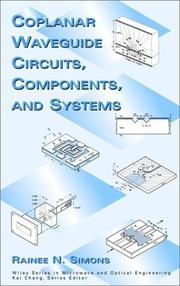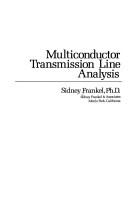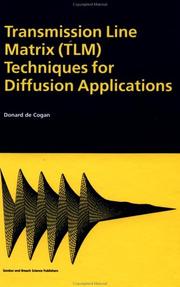| Listing 1 - 10 of 167 | << page >> |
Sort by
|
Book
Year: 1985 Publisher: Bruxelles : ECCS - CECM - EKS,
Abstract | Keywords | Export | Availability | Bookmark
 Loading...
Loading...Choose an application
- Reference Manager
- EndNote
- RefWorks (Direct export to RefWorks)
Towers --- Transmission lines --- Towers --- Transmission lines
Book
ISBN: 1504463439 Year: 2020 Publisher: New York, New York : IEEE,
Abstract | Keywords | Export | Availability | Bookmark
 Loading...
Loading...Choose an application
- Reference Manager
- EndNote
- RefWorks (Direct export to RefWorks)
IEEE Std 1838 is a die-centric standard; it applies to a die that is intended to be part of a multi-die stack. This standard defines die-level features that, when compliant dies are brought together in a stack, comprise a stack-level architecture that enables transportation of control and data signals for the test of (1) intra-die circuitry and (2) inter-die interconnects in both (a) pre-stacking and (b) post-stacking situations, the latter for both partial and complete stacks in both pre-packaging, post-packaging, and board-level situations. The primary focus of inter-die interconnect technology addressed by this standard is through-silicon vias (TSVs); however, this does not preclude its use with other interconnect technologies such as wire-bonding.
Book
Year: 1976 Publisher: Cambridge, Mass. National Bureau of Economic Research
Abstract | Keywords | Export | Availability | Bookmark
 Loading...
Loading...Choose an application
- Reference Manager
- EndNote
- RefWorks (Direct export to RefWorks)
This paper suggests and examines a straightforward diagnostic test procedure that 1) provides numerical indexes whose magnitudes signify the presence of one or more near dependencies among columns of a data matrix X, and 2) provides a means for determining, within the linear regression model, the extent to which each such near dependency is degrading the least- squares estimation of each regression coefficient. In most instances this latter information also enables the investigator to determine specifically which columns of the data matrix are involved in each near dependency. The diagnostic test is based on an interrelation between two analytic devices, the singular-value decomposition (closely related to eigensystems) and a matching regression-variance decomposition. Both these devices are developed in full. The test is successfully given empirical content through a set of experiments that examine its behavior when applied to several different series of data matrices having one or more known near dependencies that are weak to begin with and are made to became systematically more nearly perfectly collinear. The general diagnostic properties of the test that result from these experiments and the steps required to carry out the test are summarized, and then exemplified by application to real economic data.

ISBN: 0471161217 9780471224754 9780471161219 0471224758 1280367474 9786610367474 0470347511 0471463930 9780471463931 Year: 2002 Publisher: [Hoboken, New Jersey] [Piscataqay, New Jersey] John Wiley,2001. IEEE Xplore
Abstract | Keywords | Export | Availability | Bookmark
 Loading...
Loading...Choose an application
- Reference Manager
- EndNote
- RefWorks (Direct export to RefWorks)
Up-to-date coverage of the analysis and applications of coplanar waveguides to microwave circuits and antennas The unique feature of coplanar waveguides, as opposed to more conventional waveguides, is their uniplanar construction, in which all of the conductors are aligned on the same side of the substrate. This feature simplifies manufacturing and allows faster and less expensive characterization using on-wafer techniques. Coplanar Waveguide Circuits, Components, and Systems is an engineer's complete resource, collecting all of the available data on the subject. Rainee Simons thoroughly discusses propagation parameters for conventional coplanar waveguides and includes valuable details such as the derivation of the fundamental equations, physical explanations, and numerical examples. Coverage also includes: . Discontinuities and circuit elements. Transitions to other transmission media. Directional couplers, hybrids, and magic T. Microelectromechanical systems based switches and phase shifters. Tunable devices using ferroelectric materials. Photonic bandgap structures. Printed circuit antennas.
Microwave transmission lines --- Antennas (Electronics) --- Microwave transmission lines. --- Wave guides.
Book
ISBN: 2709109182 Year: 1983 Publisher: Paris : Editions Radio,
Abstract | Keywords | Export | Availability | Bookmark
 Loading...
Loading...Choose an application
- Reference Manager
- EndNote
- RefWorks (Direct export to RefWorks)
Book
ISBN: 9780470546659 9780780310179 0470546654 Year: 1995 Publisher: New York [Piscataqay, New Jersey] Institute of Electrical and Electronics Engineers IEEE Xplore
Abstract | Keywords | Export | Availability | Bookmark
 Loading...
Loading...Choose an application
- Reference Manager
- EndNote
- RefWorks (Direct export to RefWorks)
Co-published with Oxford University Press. A volume in the IEEE Press/OUP Electromagnetic Wave Series. Gain a thorough understanding of one of the most important simulation tools in computational electromagnetics with this comprehensive introduction to the TLM method. Written by one of the foremost researchers in the TLM method, this book covers the entire area of electromagnetics from the basic principles to advanced formulations and applications and including microwaves, antennas, RCS, electromagnetic compatibility, and electromagnetic heating, while providing a clear explanation of modeling principles from lumped components through 1, 2 and 3 dimensional complex systems.

ISBN: 0890060541 9780890060544 Year: 1977 Publisher: Dedham: Artech House,
Abstract | Keywords | Export | Availability | Bookmark
 Loading...
Loading...Choose an application
- Reference Manager
- EndNote
- RefWorks (Direct export to RefWorks)
Book
Year: 1960 Publisher: Paris : Masson,
Abstract | Keywords | Export | Availability | Bookmark
 Loading...
Loading...Choose an application
- Reference Manager
- EndNote
- RefWorks (Direct export to RefWorks)

ISBN: 9056991299 Year: 1998 Publisher: Amsterdam : Gordon and Breach,
Abstract | Keywords | Export | Availability | Bookmark
 Loading...
Loading...Choose an application
- Reference Manager
- EndNote
- RefWorks (Direct export to RefWorks)
Book
ISBN: 3597100481 Year: 1978 Publisher: München : Minerva-Publikation,
Abstract | Keywords | Export | Availability | Bookmark
 Loading...
Loading...Choose an application
- Reference Manager
- EndNote
- RefWorks (Direct export to RefWorks)
| Listing 1 - 10 of 167 | << page >> |
Sort by
|

 Search
Search Feedback
Feedback About UniCat
About UniCat  Help
Help News
News